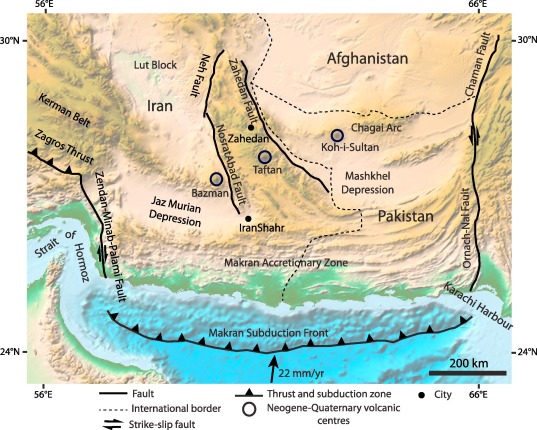Why in the News?
New satellite data in Geophysical Research Letters (October 2025) shows Iran’s Taftan volcano, dormant for 710,000 years, is reactivating.

About Taftan Volcano:
- Location: Situated in southeastern Iran, about 56 km from the Pakistan border, within the Makran continental volcanic arc.
- Elevation: Rises to 3,940 metres (12,927 feet), Iran’s only active volcano in the Makran arc.
- Tectonic Origin: Formed by subduction of the Arabian oceanic plate beneath the Eurasian continental plate.
- Volcanic Type & Composition: A stratovolcano composed mainly of andesitic and dacitic lava, with pyroclastic flows and volcanic breccias.
- Structure: Features two summits, Narkuh and Matherkuh, and extensive ignimbrite and lava fans stretching over 30 km.
- Hydrothermal Activity: Hosts sulfur-emitting fumaroles, visible from up to 100 km, sustained by an active hydrothermal system.
- Eruptive History: Major activity phases around 8 Ma, 6 Ma, and 0.7 Ma; last lava flow dated to about 6,950 years ago.
- Recent Observations: 2023–24 satellite data detected 9 cm ground uplift, indicating subsurface pressure buildup and reclassification from extinct to dormant.
Scientific Interpretation and Outlook:
- Magma Dynamics: Uplift linked to gas accumulation or shallow magma intrusion at 490–630 m depth, possibly fed by deeper chambers (~3.5 km).
- Current Status: No imminent eruption expected; likely pressure release via degassing or minor eruptions.
- Monitoring Gap: Lack of ground-based GPS or seismic sensors; reliance on satellite InSAR data for deformation tracking.
- Scientific Recommendations: Call for establishing a volcano observatory in southeastern Iran for real-time monitoring and gas analysis.
- Regional Significance: Highlights Makran arc tectonic activity and underscores the need for international geophysical collaboration.
- Research Importance: Taftan’s reawakening demonstrates the role of remote sensing in detecting hidden volcanic unrest and stresses continuous monitoring to assess eruption potential and regional hazard mitigation.
| [UPSC 2024] Consider the following: 1. Pyroclastic debris 2. Ash and dust 3. Nitrogen compounds 4. Sulphur compoundsHow many of the above are products of volcanic eruptions?Options: (a) Only one (b) Only two (c) Only three (d) only four* |
Get an IAS/IPS ranker as your 1: 1 personal mentor for UPSC 2024

